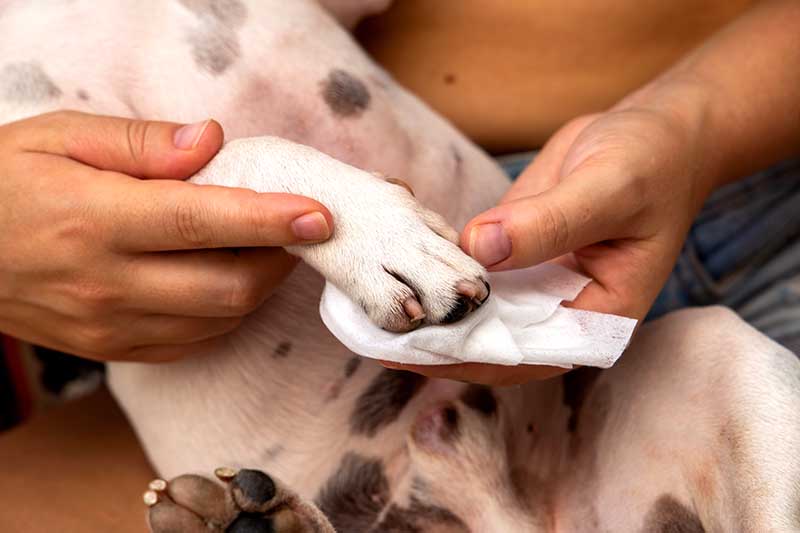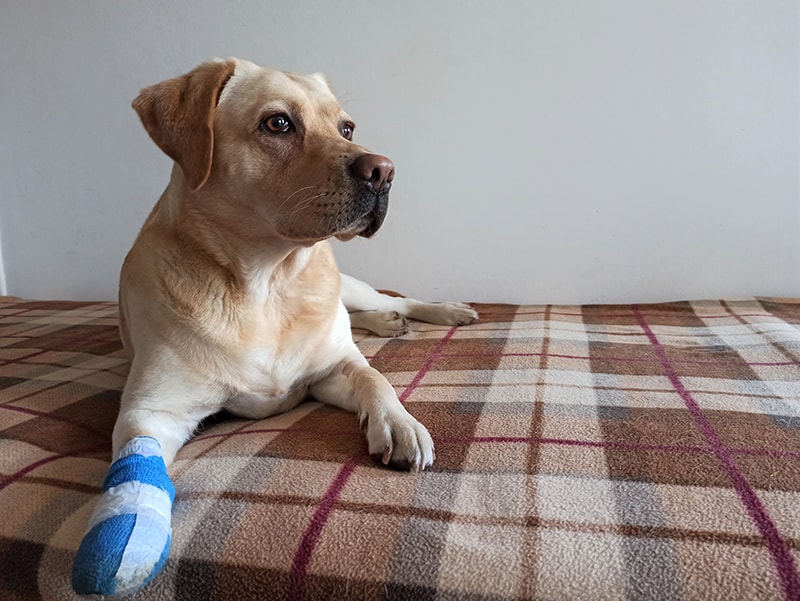
Dogs’ paw pads are designed to be tough enough to withstand the daily wear and tear of walking, running, and playing. They’re just as delicate as human feet and require loving attention to stay healthy. But sometimes dogs end up with cracked and painful paw pads, often as a result of outdoor romps in cold weather or coming into contact with caustic, hot, or abrasive surfaces.
If the problem progresses, dogs’ paw pads sometimes end up deeply cracked, which can cause pain and make it difficult for pets to walk comfortably. While home remedies often work well if the cracks in your pet’s paws aren’t that pronounced, reach out to your veterinarian if your dog’s paws begin to bleed or your buddy shows signs of pain, such as licking the area or restlessness. Below you’ll find a step-by-step guide for healing cracked dog paws.
The 5 Steps to Heal Cracked Paw Pads
1. Gather Your Supplies
To ensure the process moves along as quickly as possible, gather all required supplies before starting. You’ll need a basin to fill with warm water, dog-friendly anti-bacterial soap, and two clean towels. Have petroleum jelly, bandages, or socks on hand and ready to go.
Find a place where your dog feels safe and secure, so you can easily reach its paws. Consider putting down a towel to protect the furniture and floor, and have plenty of warm water on hand for rinsing.
2. Wash the Wound

Spend a few minutes looking over your pet’s paw and remove any debris that may be stuck. Use the water and the cloth to clean the wound gently. Rinse the injured area thoroughly after you’re done cleaning it.
Dry your pet’s paw and rub petroleum jelly into the pad. Cover the wound with a bandage or sock to prevent your pet from licking the area. At times when you can’t monitor your dog closely, using a comfy collar might be very helpful to stop your dog from trying to remove the dressing.
3. Consider Using a Paw Moisturizer
Consider using a canine-friendly topical moisturizer to speed the healing process and provide your buddy with a bit of relief. Just make sure to supervise your pet so they don’t lick all the good stuff away after you put it on their paw!
4. Take It Easy

Paw pads often take time to heal, so your dog may benefit from shorter walks and less activity while giving the injury time to heal. Try not to let your dog walk on hot, cold, sharp, or abrasive surfaces while their paw pads improve. Potentially irritating chemicals, like deicers and cleaning products, should also be avoided.
5. Take Your Dog to the Veterinarian
Minor paw cracks can often be treated at home, but keep an eye on your dog and contact your veterinarian if things aren’t improving within a few days. Dogs’ attempts to relieve pain and itchiness by licking and biting often lead to further problems, such as infections that need antibiotic treatment.
Consider having a veterinarian look at the problem if it persists for longer than just a few days, as several medical conditions can cause skin problems, such as cracked paw pads.
What Causes Cracked Dog Pads?
Cracked paws often occur as a result of general wear and tear or after long walks on a rough surface. Contact with things like deicers and cleaning products can cause irritation. The skin covering the paw pad will get damaged, dry out and loose its normal barrier function. At the same time, dogs often lick painful, inflamed areas, which can make the paw sore and can increase moisture making it more prone to infections.
Food allergies or atopy can make your dog lick their paws excessively, leading to pad problems. Immune, liver, and metabolic diseases can cause paws to crack, but you would normally see other signs in your dog. There’s even a condition, hyperkeratosis, in which dogs develop thickened skin in paw pad and nose, leading to issues in these areas.

How to Avoid Paw Pad Wear and Tear
Avoiding cracked paws is often far easier than treating the injuries afterward. It’s often difficult for dogs to stay off their feet during recovery, and many are inclined to lick away ointments and medications. Often, an Elizabethan collar or a comfy or cloud collar is required to facilitate healing.
You can quickly wipe down your buddy’s paws after walks to remove any debris or potentially caustic chemicals, particularly during cold weather. If your pet loves being outside and you live in a colder environment, consider investing in booties to protect your dog’s paws during walks.
Alternatively, a canine-friendly cream can provide protection from the elements. Keep your dog away from hot surfaces during the summertime, and try to walk on softer surfaces to prevent paw-cracking. Concrete and hot sand are two common summertime paw hazards.
Conclusion
Dogs’ paw pads are tough yet sensitive. They’re thick enough to let dogs comfortably walk over various surfaces, but sometimes, their paw pads end up irritated and inflamed. It can happen due to encountering harsh chemicals or after walking on rough surfaces too long. But allergies and some types of medical conditions can also cause cracked paws.
While it’s often possible to treat minor paw cracks at home with soap, water, and petroleum jelly, or a paw balm, consider taking your pet to the vet if your dog’s paw pads are bleeding or your pet starts showing other signs of discomfort, such as lethargy, decreased appetite or excessive licking.
Featured Image Credit: GaiBru Photo, Shutterstock








